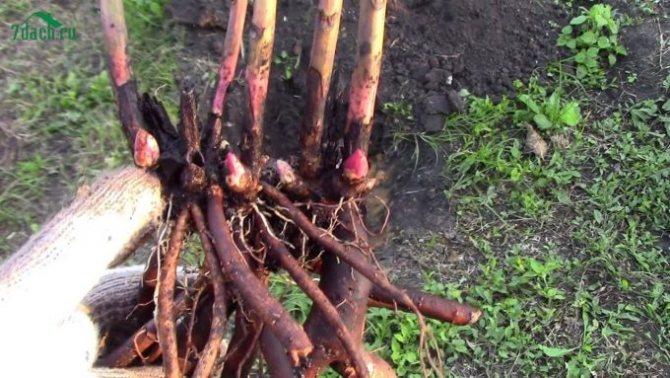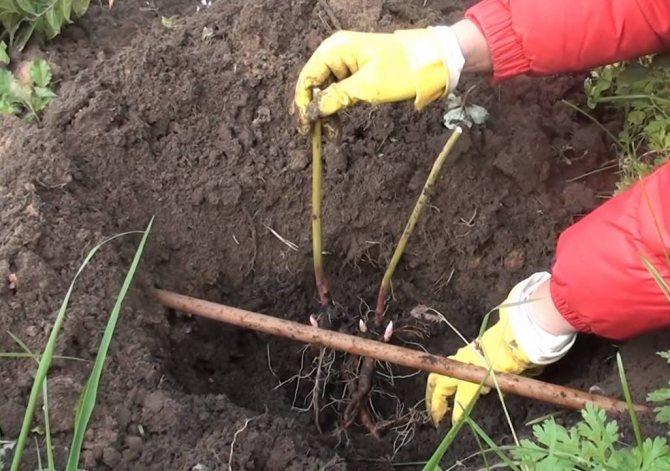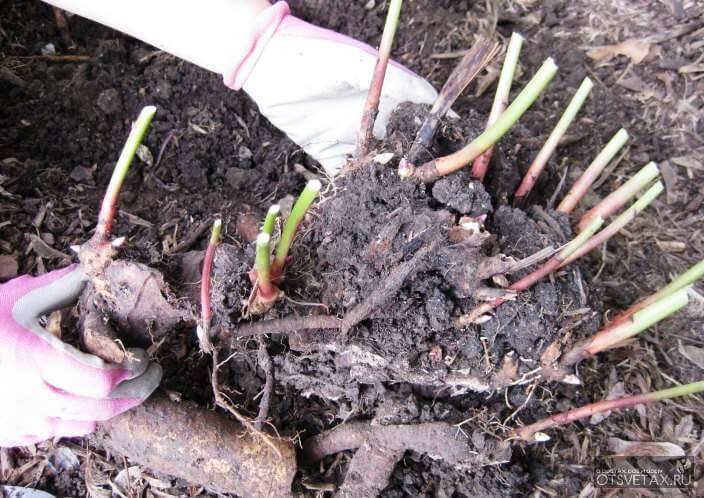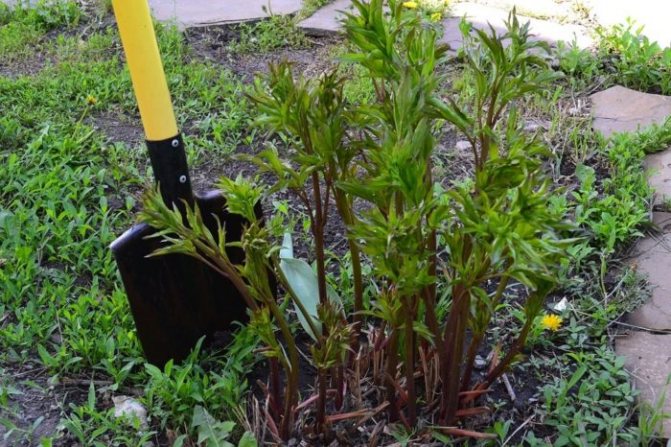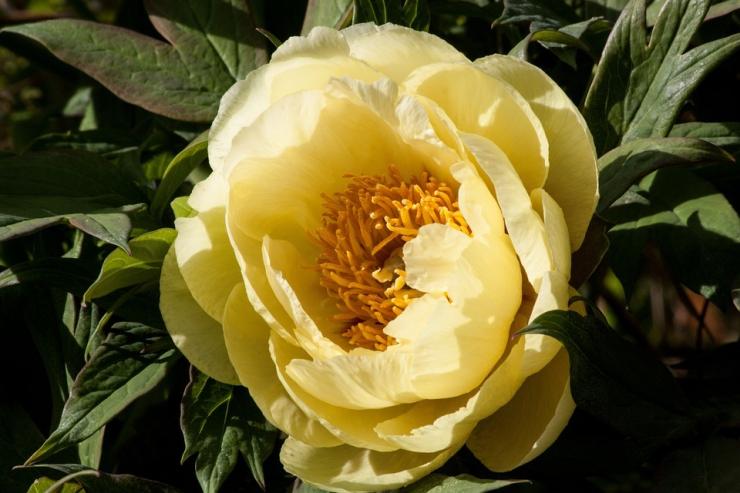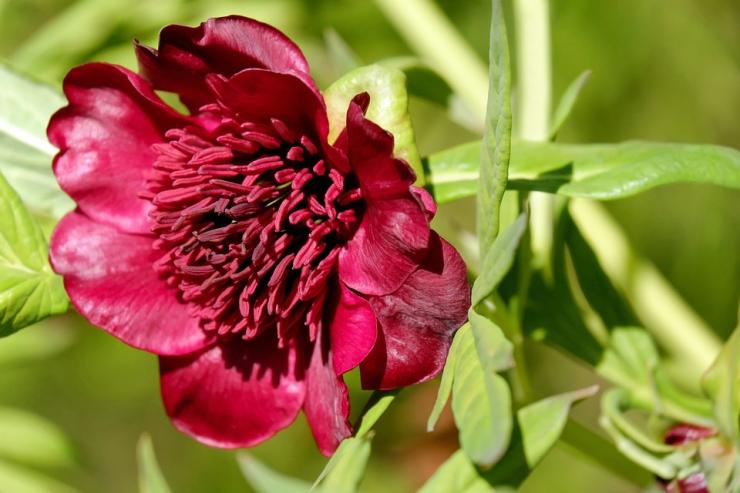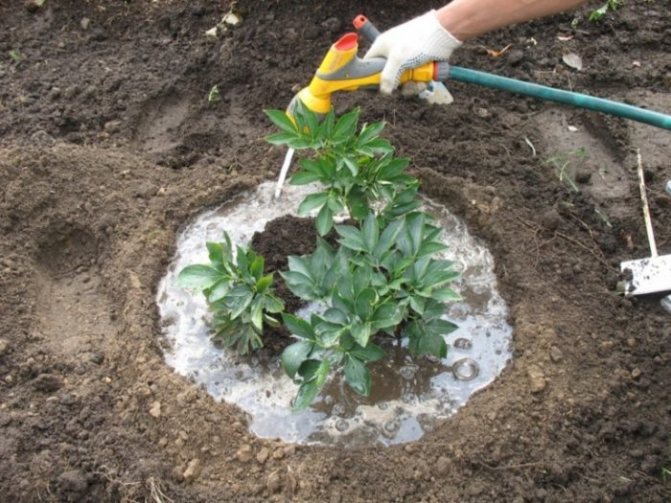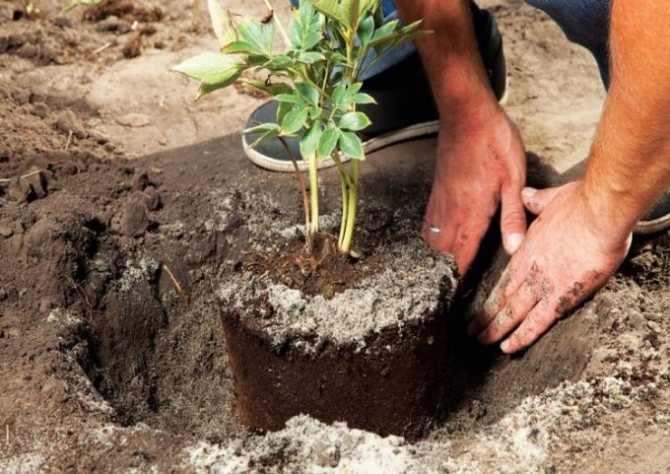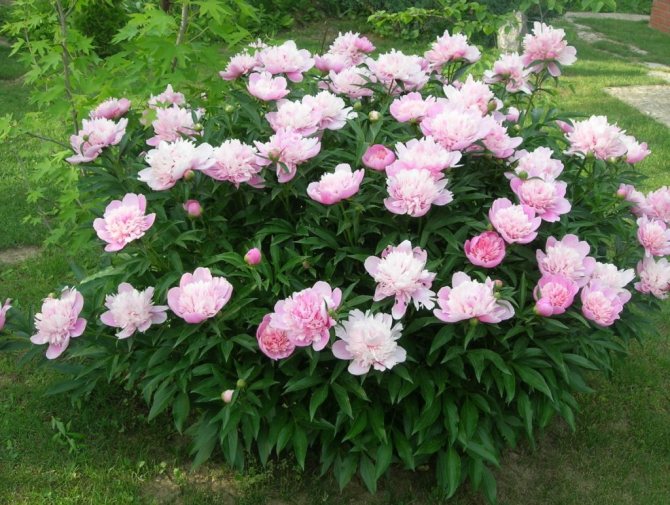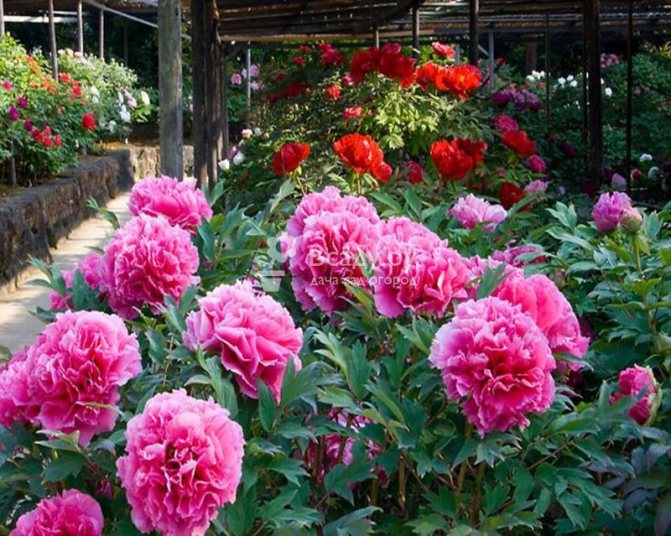Peony belongs to an extremely unpretentious variety of plants; it can grow normally in the same place for a whole decade. However, sometimes it is required to rejuvenate the bush or propagate it, and in such a situation there is only one way out - transplanting a peony to a new place.
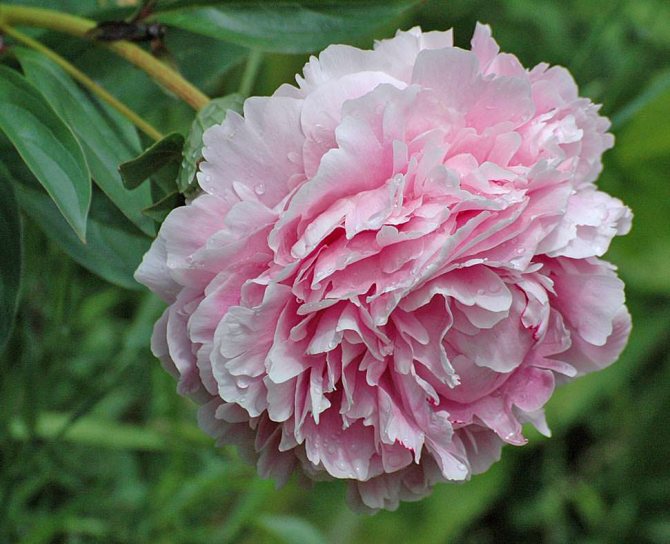
Seat selection
When choosing a place for transplanting a peony, you need to pay attention to some points:
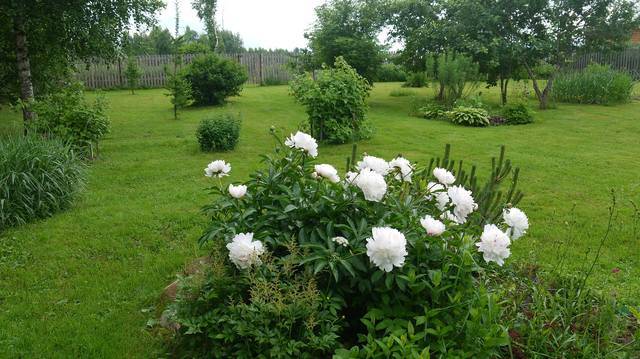

- peonies feel more comfortable in illuminated areas, so you need to allocate an open place for the bushes, but protected from the wind;
- walls heated by the sun have a detrimental effect on flowers, so they should be transplanted in the fall no closer than two meters from home;
- the site for replanting bushes should be in an elevated place with light shade so that the transplanted bushes do not wither from the heat and, at the same time, receive sufficient lighting.
Peonies are rather unpretentious to the composition of the soil - they survive in both sandy and clay soils. But although the sand accelerates the flowering of the bushes, they fall off faster, and the high content of clay in the ground delays flowering. Therefore, it is better to monitor their optimal ratio. Peonies grow best on loamy soils.


Transplant depending on the type of peony
The recommendations for transplanting described above are given for the most common and unpretentious - herbaceous peonies.
Treelike varieties and Ito hybrids require more respect for themselves. Without special need, you should not disturb the plants.
Tree peonies are transplanted in August-September as well as herbaceous ones. Particular attention must be paid to the gentle extraction of the plant from the soil. The roots of treelike peonies are fragile and reach a length of 80 cm.
- The branches of the bush are tied into a bunch so that they do not interfere with work and do not break.
- The bush is dug in around the circumference, stepping back from the center 40 cm. First, they dig a trench on the bayonet of the shovel, then they take the pitchfork, climbing inward, to the roots.
- Carefully swinging the peony, they pry an earthen lump with roots onto the pitchfork and remove it from the pit.
Ito peonies are transplanted using the same technology as tree ones. The most important point in placing a bush in a hole is not to deepen the growth buds.


Hole preparation
Pits for planting peonies should be prepared two to three weeks before planting:
- the more spacious they are, the more powerful the root system will become;
- leave a distance of about a meter between the bushes for fresh air circulation;
- the root of the plant should fit freely in the hole;
- as a drainage, the bottom can be laid out with a layer of pebbles or broken bricks mixed with chopped twigs, and covered with the prepared earthen mixture;
- you need to ensure good watering of the hole so that the soil settles enough;
- introduce a little nitrogen and phosphorus compounds into the hole - they are enough to feed the transplanted peonies in the first years after transplantation.
Care
Caring for peonies is quite easy and will not cause much trouble even for novice growers. It consists in the following:
- The first sprouts of peonies must be irrigated with Bordeaux liquid
In early spring, after the soil has thawed, the peonies must be watered special solution. To obtain it, 2-3 grams are added to 10 liters of water. potassium permanganate. The specified volume should be enough to water two bushes at once.This will not only accelerate growth, but also prevent a number of diseases. - When the first shoots appear, they will need to be irrigated with Bordeaux liquid, then loosen the ground around them. This must be done very carefully so as not to damage the young shoots.
- In spring, humus can be used as fertilizer, and when the first buds appear, fertilize the bushes with a mullein solution. At the end of summer, it is necessary to repeat a similar bait course.
- The first few years after planting, the soil near the peonies is necessary keep it loose, the approximate loosening depth is about 5 cm.
- Twice a year it is necessary to carry out abundant watering, this is done at the beginning and end of summer, since during these periods the peonies require much more nutrition and moisture.
Transplant timing
Many people doubt when to transplant peonies, in spring or autumn. Choosing the right timing is of great importance, since both seasons are suitable for replanting them.


- Some beginners consider it possible to transplant flowers in the summer, after flowering, but in this case they take root much more difficult and may not bloom for a year or two. Often, the roots of a plant dug out in summer die from sunburn or are damaged.
- With a spring transplant, the bushes will not bloom in the current season either, since they will need adaptation in a new place. If there is a need for a spring transplant, it is better to do it in early spring, before the vegetation process of the plant begins. The spring transplant should be carried out immediately after the snow melts, and the division and pruning of the root in the spring cannot be done - after all, the bushes are already stressed, and they still have to take root in another place.
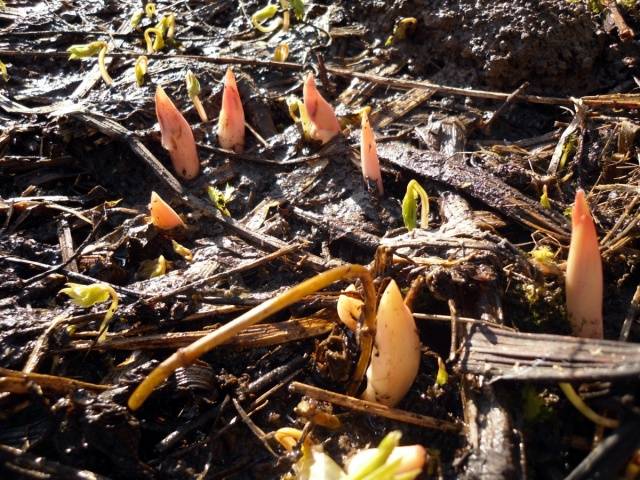

- The most suitable period when it is better to transplant peonies is the end of summer - beginning of autumn. At this time, the heat subsides, and moderate watering will ensure the rapid development of the root system. A strong root will give the transplanted shrub good nutrition. But the main advantage of the autumn peony transplant is that at this time, thin young roots have already formed, with the help of which nutrients are absorbed.
Important! If the peony is transplanted correctly in the fall, then within several years it will give a large beautiful bush.


How to properly transplant a peony to another place?
The transplanting scheme differs from planting in that first the bush must be dug up and divided into parts. Further actions are identical: preparation of the planting pit, soil mixture, adherence to planting rules and further care.
We remind you that you can transplant a flower for the first time not earlier than 4-5 years after planting. Such delenki will grow and bloom better. And if the bush began to bloom worse and hurt more often, after 10-12 years of growth in one place, then it is recommended to move it to a new place.
How to dig up peonies?
- The roots of the plant are able to penetrate up to 80-90 cm in depth, while they are quite delicate.
- Therefore, you need to dig carefully, and better with a pitchfork. At a distance of 40-50 cm (about 40 cm - a 4-5-year-old specimen, the older it is, the greater the distance), dig in the ground around the bush with about two bayonets, loosen it and try to get it out of the ground with two shovels.
- Gently wash the rhizomes from the soil with a jet of water.
- Cut off the aerial part at a height of 4-6 cm, and put it in the shade for 3-4 hours so that the roots soften a little.


Digging a bush for further division into divisions
How to split a peony bush?
It is not so easy to divide the bush into "delenki": the roots are tightly intertwined, and it is not always easy to find suitable pieces of rhizomes (size, buds and adventitious roots).
- Using a knife, cut the rhizome into 8-12 cm pieces, which will have 3-4 buds and 3-4 adventitious roots (length at least 5, diameter 0.8-0.9 cm). It is better if there are three buds, and a maximum of five (large "delenki" with a large number of buds are not recommended to be transplanted).If the bush is very old, then a wedge can be hammered into the middle of the rhizome, which will split it into a couple of pieces and then act according to the situation.
- Carefully inspect each section and, if found, cut off rotten and small roots.
- Treat the cuts and the entire bush with preparations with copper (Bordeaux mixture, copper oxychloride, etc.) and sprinkle the cuts with charcoal powder. Leave the seedlings outside in a shady place for a day.
- To prevent the appearance of root rot, place the roots in a solution of potassium permanganate for 1-2 hours before planting (1 g per 2.5-3 liters of water).
- For convenience, attach a label with the characteristics of the variety and bush for each division.
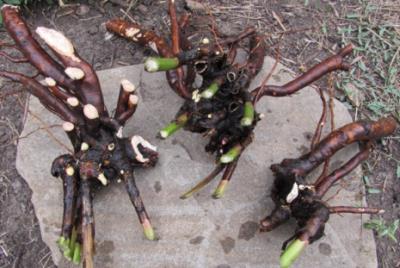

Peony delenki ready to transplant
ADVICE
- If you share a large rhizome, then you need to remove very old parts (usually they are hollow and rotten), and rinse the cuts with potassium permanganate and sprinkle with fungicide (copper sulfate, potassium sulfur or modern preparations - see the article on fight against powdery mildew - the head of the facility).
- If your favorite flower suddenly broke off a part of the root with one single bud, then do not despair. Repot and take care of the cut anyway. In most cases, the seedling will survive and will be just as beautiful, only the bush itself develops more slowly. What's more, try sprouting just pieces of the root. After all, kidneys can hatch on it in 1-2 years. To do this, dig it in and water it periodically.
- A delen with many buds and a small number of thick storage roots will develop poorly due to lack of nutrients. And if on the contrary, the root system will develop poorly.
- A tree with 1-2 buds and a piece of rhizome blooms a year later due to slow development, but as a result a healthy and developed bush will grow. It is better to grow them on separate beds.
PREPARATION FOR TRANSLATION
Before transplanting a peony to a new place, moisten its roots in a solution with a growth stimulant (Heteroauxin, Root, Amber Acid).
After wetting, the seedling is dried for 5-10 minutes.
Next, we carry out the landing of the "delenki" according to all the rules and take care of it, as after landing. The instructions are given below in the article.
Features of the suction roots
Each bush has several thousand suction roots, which are almost invisible to the naked eye (slightly thicker than a cobweb) and go vertically down to a great depth. It is for them that they dig so deep planting holes, make a layer of top dressing and drainage, if groundwater is located close.
Many growers mistake white short roots for suction roots, but they are an annual continuation of thick storage roots that appear at the end of September.
Therefore, planting peonies and harvesting delenki is advised from the end of August to the end of September, before they appear.
Peony transplant
After the place is prepared and the earth settles well, it is important to transplant the peonies correctly. For work, it is better to choose a dry, but not hot day without the sun.
- Before the autumn transplanting, it is necessary to prune the bush to a height of 20 cm. Then very carefully dig out the peony bush, prying it with a pitchfork. Do not dig too close to the trunk, otherwise roots and young shoots can be damaged.
- From the dug out bush, you need to carefully, with your hands, remove clods of earth, but you must not shake it and even more so hit it on anything. The video shows the process of dividing the root system of a peony:
- Carefully examine the roots, remove damaged or rotten ones and treat the roots with a solution of potassium permanganate.
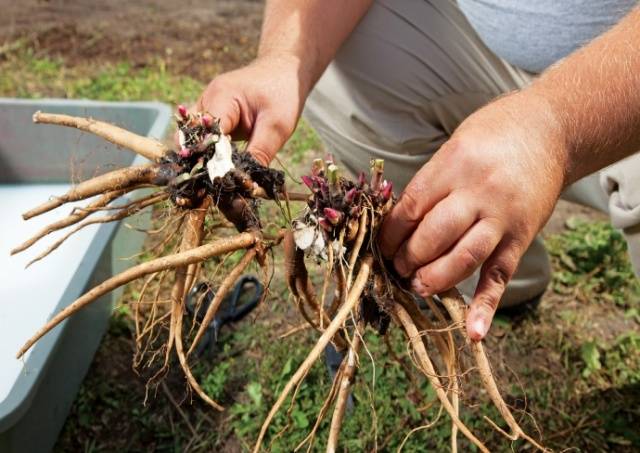

- If you hold the bush in the shade for 2-3 hours before planting, then the roots will acquire greater elasticity and will no longer be too fragile.
- If the bush is simply transplanted, you need to carefully transfer it to the hole, spread the roots, cover it with earth and lightly tamp it.
How to plant peonies correctly? Instructions
- Pit. The dimensions of the planting pit for tree-like peonies and tall herbaceous: width - 50-60 and depth - 70-80 cm. Low-growing herbaceous: width - 40-50, and depth - 60-70 cm.
- Top dressing layer. Fill 65-70% of the pit volume with a nutrient mixture. Composition: peat, turf soil, sand (except for sandy soils) and humus in equal parts + 300-350 g of bone meal or wood ash, 100-180 g of superphosphate, 100-150 g of potassium sulfate and a tablespoon of ferrous sulfate.
- Upper layer. We cover the top with ordinary soil, at least 15-20 cm layer, and plant the rhizome at the desired depth.
- Then gently compact the soil with your hands and sprinkle with 8-10 liters of water, and to conserve moisture, scatter wood ash over the surface.
- For the winter, the peony needs to be sprinkled or sprinkled with a 10-14 cm layer of peat.
EXPLANATION
DRAINAGE. When groundwater rises close to the roots and to lower its level in the aisle, you need to dig a drainage hole, completely fill it with rubble, pebbles or broken brick. In this case, keep the root collar of the plant above the aisle.
Many articles on transplantation write about creating drainage at the bottom of the planting pit, but for herbaceous peonies there is no need, but for tree peonies it is possible. Drainage is required in places with a high level of groundwater, where they are planted on high ridges.
FERTILIZERS. When planting a flower, fertilization is vital. They will help you develop well and be strong. Phosphate fertilizers are also added so that brown spots do not form on the leaves over time.
When feeding after transplantation, phosphorus often forms insoluble compounds and settles at a shallow depth. It is better to use organic phosphorus fertilizers (bone meal) than mineral fertilizers (superphosphate), as they gradually decompose and feed the flower for a long time.
It is useful to add rotted weeds from clay soil to the bottom layer of top dressing. It is clay soil that retains nutrients, unlike sand, peat or podzol.
TOP. The upper layer of the planting pit (at least 15-20 cm) should not contain fertilizers, therefore, it is covered with ordinary loose soil from above so that the roots stretch down and oxygen flows to them.
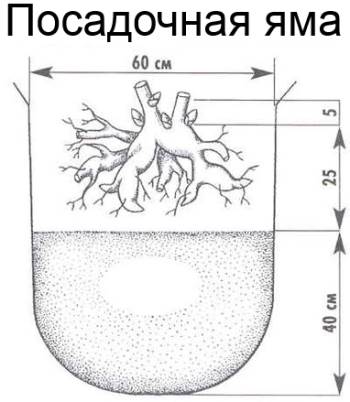

Diagram of a pit for planting a peony
ADVICE
- It is better to dig a hole and prepare it 15-30 days before planting. During this time, the earth will sink, and then you will immediately plant the peonies at the desired depth.
- For better survival of the flower, dip the roots in a paste-like solution of clay with "Heteroauxin" and two tablets of copper sulfate for 3-4 minutes. Then dry for 5-10 minutes, and plant in the ground. You can also use simple growth stimulants without clay.
- If the pH is below 6.5, then add 100 grams of slaked lime, and if it is below 6.0, then 200 grams per bush.
- Attention! Touch the roots gently as they are quite fragile.
- Read more about the principles of planting in a special article - link at the bottom of the page.
How to make planting compost?
In an area that is well warmed by the sun, make a narrow pile of weeds. This will allow air to flow in and aerobic bacteria will develop. If it's not raining, water the compost to help the earthworms crawl.
Only when laying a planting hole, add mineral and organic fertilizers to the compost.
Reproduction of a peony in autumn
How to transplant peonies if the root system has already grown well and needs to be divided? To do this, you need to use a previously disinfected sharp pruner or knife. Roots are subject to division, on which there are at least six buds. The slightly dried root is cut in such a way that three buds remain on each part. After dividing, each part should be dipped in a disinfecting solution or smeared with ash.
When transplanting the prepared material into the holes, the root should not be buried - a depth of up to 9 centimeters is enough.The buds need to be left on the surface, and then sprinkle them on top with fertile soil 5-6 centimeters high. The transplanted peony bush must be well watered. Before the onset of frost, another 2-3 watering is required. But too much watering should not be allowed - the roots can rot. You can mulch the bush with foliage for the winter and cover it with cardboard.
The video shows the process of correctly transplanting peonies:
Transplant rules
It is important not only to choose the right period for transplanting a peony, but also to carry out this process correctly. Its main features and rules that must be followed are listed below:
- A few weeks before transplanting, special pits must be prepared at a new location. Their diameter, as well as their depth, should be about half a meter, the distance between the holes should be at least one meter. The depth can be increased by 15-20 cm if an additional drainage layer is expected. The bottom of the pits is covered with small stones or sand, and then repeatedly watered with water, which should ensure high-quality soil subsidence in this place.
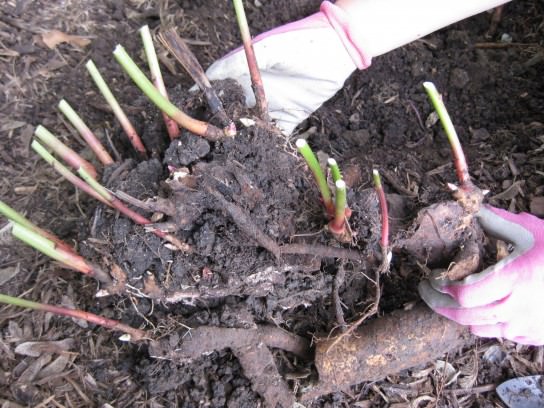

You need to trim the leaves when transplanting, leaving trunks 5 to 10 cm long In the place where the rhizome of the transplanted bush will be located, the soil must be additionally fertilized. To do this, you can mix the same amount of wood ash, black soil, manure and peat. Just before planting the bush, this mixture should be placed in holes and mixed with regular garden soil.- In the old bush, you need to cut off the stems so that only hemp 5-10 cm in height remains. It is especially difficult to replant old plants that are more than 8 years old, since they have a bulky rhizome, and it is very easy to damage it when digging up. For this reason, it is recommended that you stop using the shovel and replace it with a pitchfork. The bush is dug in carefully and without sudden movements, at a great distance from the stem. If the working tool feels for an obstacle in the soil, then the distance must be increased, as this may be part of the root.
- If traces of decay are found in the excavated rhizome, such places should be cut off with a knife, and the place was immediately processed with a solution of potassium permanganate.
- If the transplant is carried out in the spring, it is forbidden to wash, disinfect or separate the rhizome, since the plant will have a difficult period of adaptation to a new place without it.
After all the described actions are completed, the most difficult part will be left behind. It remains only to transfer the peony to the dug and prepared pits to plant in a new place, and then wait until it takes root and begins to bloom.
After transplant
Experienced gardeners advise pruning flowers that appear in the first year after an autumn transplant. This will allow the plant to grow stronger faster and give abundant flowering next year.
If the peony bush has stopped blooming after transplanting, the following reasons are possible:


- there is a lack of sunlight in the new place;
- if the groundwater comes close to the soil surface, and there is no drainage, the roots of the peony can rot;
- perhaps the plant was transplanted too deep, which delayed its flowering;
- if during reproduction the root was divided into too small parts, you will have to wait several years until it gains strength for flowering;
- frequent transplanting of bushes weakens them, therefore, it is recommended to transplant no more than once every 5-7 years;
- perhaps the peonies do not have enough nutrition and should be fed.
How to transplant peonies to bloom? Location, soil, distance, depth
In order for peonies to bloom, you need to transplant them correctly. For their growth and development, such factors must be taken into account: place, soil, timing, planting pit, distance, planting depth and the seedling itself.
NEW PLACE
When transplanting to another place, you need to choose one that can provide them with comfortable conditions for development and flowering.It should be free of drafts, and be illuminated by the sun for a long time.
Ideally, let the sun hit the flower for 4-5 hours in the morning, while a little shade in the midday heat will prolong the flowering. It is optimal to choose the east side.
Bad choice
- If water accumulates there. Even 1-2 times a year in spring or autumn for a couple of days.
- Shady place. Herbaceous and tree-like peonies are contraindicated in shade even 2-3 hours a day.
- Close to trees (3 m), bushes (1.5-2 m) and buildings (1.5-2 m). Large shrubs and trees “take” nutrients from flowers, and materials in the house generate heat and create temperature imbalances.
SOIL AND ACIDITY
The optimum acidity level is pH 6.2-6.8.
Herbaceous and tree-like peonies prefer well-drained and loamy soil.
See also: HOW TO KNOW SOIL ACIDITY?
TRANSFER DISTANCE
Low-growing varieties when planted in a row - 70-80 cm, in other situations - 90-110 cm, and for vigorous and tree-like peonies - 1.3-1.8 meters. The distance between the bushes plays a significant role, so it is better to take a small stock than to reduce the spacing.
WHAT DEPTH TO PLANT THE PIONES?
The correct planting depth is 3-4 cm (heavy soil) and 5-7 cm (light). It is in these conditions that the rhizome does not suffer from heat or cold. By the way, a deeper planting is fraught with a lack of flowering.


Adjusting the planting depth of the peony
Autumn pruning of peonies
Novice gardeners usually make the mistake of pruning peony bushes as soon as they finish flowering. During this period, the bushes should not be touched, because buds are laid in them, which will ensure flowering in the next season. Pruning should be carried out in the fall, when preparing the bush for wintering, and two weeks after the end of flowering, it is better to feed the peony with phosphorus and potassium compounds.
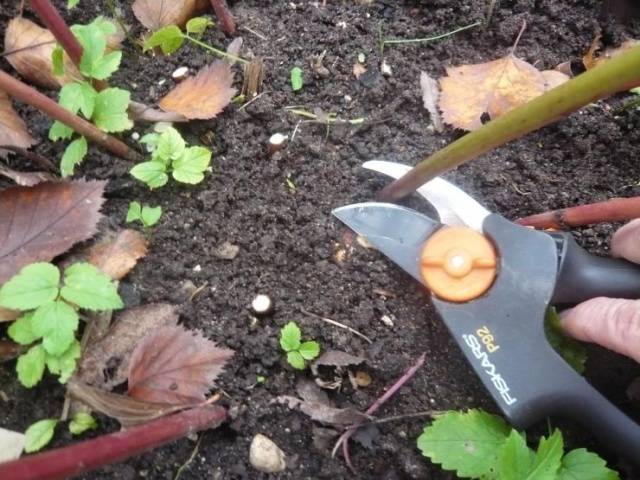

Correct pruning requires adherence to the following guidelines:
the optimal dates for autumn pruning are the last week of October or the very beginning of November, depending on the region;
- earlier pruning will greatly weaken the plants and may even cause their death;
- the bush is cut off completely, at the level of the ground surface;
- if there is no rain during this period, watering should be carried out around the bush;
- trimming twigs or leaves left at the site of the procedure will begin to rot and cause infection and subsequent diseases of the peony, so they should be collected and destroyed immediately;
- after pruning, you can feed the plant with wood ash.
Important! Pruning of peonies should be carried out in the fall, since it is much more difficult to work with soft plant stems in spring.
Peonies are unpretentious. If you follow the proposed recommendations, then every year lush beautiful buds will flaunt on the flower beds.
How to plant a plant correctly?
The basic structure of the roots of all types of peonies is the same, so the process of planting them is identical. After trimming the aboveground part, the bush is dug in, removed from the ground and left to dry for a day.
Dividing the bush
When planting a peony, healthy, young areas are separated from the root. They can be distinguished by their light shade. The rhizome is cut with a sharp, disinfected knife or shovel. In some varieties, the roots are so powerful and firm that you have to wield an ax.
General recommendations for the procedure are as follows:
- Each division should have 3-4 large buds. Although sometimes parts of the root with one viable bud take root perfectly.
- Old and damaged parts are cut out. Places of cuts are washed with a weak solution of potassium permanganate and powdered with charcoal.
- If traces of pests are visible on the rhizome, it is additionally treated with an insecticide.
Do I need to dig it up?
To separate and plant a part of the bush in a separate hole, it is not necessary to completely dig out the rhizome of the peony. For reproduction, you can use the pruning method:
- Soil is dug from the bush so that 6-8 cm of rhizomes are exposed and the buds appear.
- With a shovel, cut off the top of the rhizome with buds (you need to hold the tool horizontally). In this case, the main taproots remain in the ground.
- The separated part is cut in such a way that at least 3 buds remain on each division.
- Each division is planted in a separate pit. Small parts are placed vertically in the pit, large ones at a slight slope. The distance from the kidneys to the surface of the kidneys should be 5-7 cm.
- The part of the rhizome remaining in the old place will give new buds, and in 1-2 years the plant will fully recover.
Peony transplant is a simple procedure, but it also requires adherence to recommendations and technology. Flowering in the next season directly depends on the correct division of the bush and the care of the parts planted in separate pits.
Preparatory stage
The reason why gardeners appreciate the peony is its lush, fragrant bloom in early summer. If you plant a plant in an unprepared place, the decorative properties of the perennial are reduced, a small number of buds are formed on the bush. Transplanting a peony requires compliance with several rules for choosing a place and preparing planting material.
Preparing a place
A hole for the plant is prepared no later than 2 weeks in advance. The distance to the nearest neighbor in the flowerbed is one meter. Such a planting scheme contributes to sufficient illumination of the peony, ensures the circulation of air masses, and makes it possible for the correct development of the roots. It is necessary to transplant peonies to a lighted area, away from large trees and buildings. The landing pit is prepared using the following technology:
- at least 2 weeks before the transplant, a hole is dug to a depth of half a meter;
- the bottom layer of soil is sprinkled with a drainage layer;
- mix ½ of the earth with compost and superphosphate;
- spill the hole with water, leave it to settle and dissolve the fertilizers.
Chernozem or spring-enriched soil is not fertilized with mineral fertilizing. If a flower is to be transplanted into soil with a high pH, 1 tbsp of ash or chalk is first added to the soil.
Preparation of planting material
Young bushes are transferred to a new hole with soil. If in the process of transplanting the soil crumbled and opened the root system, you should examine the shoots and remove the dry, damaged parts with a sharp pruner. Sprinkle the cut with activated carbon or ash.
In August, overgrown peonies can be transplanted, having previously separated part of the rhizome. Watering is stopped a week before the procedure. The delicate roots are easily separated from dry soil. When dividing, the following rules are followed:
- the dug root is carefully freed from soil residues. You cannot shake and beat against the wall, this will damage the thin suction roots;
- dry in the shade for several hours;
- shorten shoots to 15-20 cm;
- with a sharp, clean knife, divide the rhizome, on which more than 6 buds are formed;
- 3-4 kidneys are left on each section;
- the place of the incision is treated with an antiseptic, a solution of potassium permanganate or a garden pitch is suitable.
In rainy weather, wet soil can stick to the rhizome. To easily assess the condition of the root system and examine the buds, it is recommended to carefully spill the plant from a garden watering can. It is necessary to clear the ground by placing the plant on a film or in a wide container. On weight, there is a high risk of injury to thin roots.
Planting and transplanting peonies in October
The best time for planting peonies is the velvet season. But after it, until October, and sometimes until November, you can see such tempting offers in shops and websites of gardening goods that it is simply impossible to resist buying a new bush.If you happen to be among those who managed to buy a peony in October, do not despair. You have every chance to successfully plant the plant and see it bloom next year.
If you don't know how to plant peonies in October, just use the following algorithm:
- Choose an ideal planting site - peonies love sunny areas with good air circulation, shade during the hottest hours, and from soil they prefer cultivated neutral loams.
- Prepare holes with a diameter and depth of about 60 cm, lay 15 cm of drainage (gravel, sand, small stones) on the bottom, spill the holes with water.
- Prepare the soil - mix equal parts black soil, neutral peat, humus and sand.
- Add 300 g of ash, 20 g of superphosphate, 10 g of urea to the prepared soil.
- Wash a freshly purchased peony in warm water, dry it and carefully examine the roots - all traces of rot must be removed with a sharp knife.
- Disinfect the root for 15 minutes in a solution of potassium permanganate, the color of red wine, and then dry.
- Plant in a prepared hole and cover with soil so that the buds are 3-5 cm deep.
It is known that peonies can grow in one place for up to 10 years and at the same time bloom beautifully. However, if this fall your views on the design of the site and the location of the plantings have changed, and you want to transplant peonies in October, you do not have to wait until the end of the ten-year period.
It is undesirable to dig out peonies with a shovel, because their roots are very fragile and break easily. It is best to do it with a pitchfork.
Carefully cut the stems and leaves of the peonies up to 15 cm. Then dig up the plants, clean them of damaged and diseased rhizomes and plant according to the scheme described above.
Finding a suitable place, preparing the soil
Transplanting peonies in the fall is most preferable. Planting pits can be prepared in advance, especially if you plan to divide the bushes and plant several divisions. The filled up nutrient soil should settle in them. If peonies are transplanted in August, you need to dig holes 14 days before planting.
Peonies grow well on well-fed soils with sufficient moisture and lighting. Plants should not be planted under trees, too close to buildings and fences that form a shade, do not allow atmospheric moisture to enter the soil.


Prepared planting material
Step-by-step instructions will help to ensure excellent survival rate:
- Choose a plant for transplanting. Cut off shoots at a height of about 15 cm from the ground.
- Step back 20-25 cm from the projection of the bush, dig in the near-trunk circle with a pitchfork. It is better not to use a shovel, as there is a risk of damage to the root system.
- Remove the whole peony, shake off the ground. If necessary, divide the rhizome, removing damaged, rotten and infected areas. Sprinkle the cuts with charcoal or ash.
- Place a cut or a whole rhizome in a previously prepared hole, gently straightening the roots and deepening the root collar with buds 2-5 cm from the soil level. Small delenki are planted vertically, and large ones at an angle.
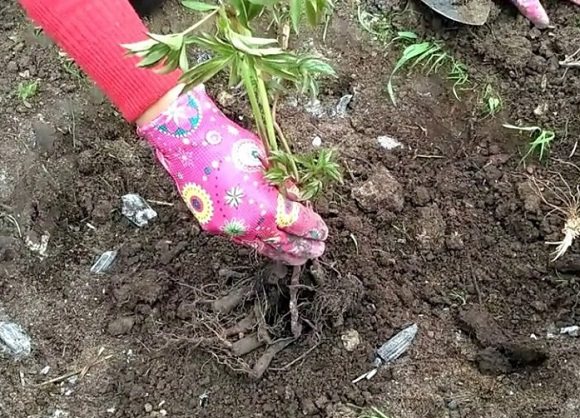

Small delenki are planted vertically - Cover the plant with fertile soil, compact.
- Water using at least 5 liters of water per seedling.
- Cover the trunk circle with sawdust, peat or bark to retain moisture.
Peonies require loose, permeable and nutritious soil. Before disembarking, they dig a hole 600x600x600 mm. Mineral fertilizers are introduced into it, consisting of 100 g of superphosphate, 50 g of potassium chloride, 10 g of ferrous sulfate, 400 g of bone or dolomite meal. Old, well-rotted humus or compost is added. It is mixed with fertile soil and left to settle. Before planting, sprinkle with fertile soil, best of all with black soil, in order to avoid fertilization on the rhizomes.
Video: instructions for dividing and transplanting peonies.
Care features
In order for the peony to grow quickly, it is important to ensure that the buds are covered by the ground by at least five centimeters.If the peony is on heavy soil, then the layer of earth should be no more than four centimeters. This should be monitored throughout the life of the plant - its successful wintering and abundant flowering depend on it.
The transplanted plant should be watered regularly, in a volume that will give the peony a sufficient amount of nutrients, but at the same time will not destroy its root system. It is important here to protect the root part of the bush from frost. In this case, mulch is perfect.
Since the plants buried in the ground are located below the young roots, it is recommended to feed and fertilize the plant - best with watering.
Immediately after transplanting peonies to another place in the fall, it is recommended to start preparing the plant for winter. Towards the end of October, all shoots should be cut at the root and thoroughly loosened up the soil, having previously watered it well. Since autumn is a rather rainy season, there is no need to water the plant. If the weather is warm, dry, the plant still needs watering.
Follow-up care
The first two weeks after transplanting, peonies should not be watered too often, so as not to provoke decay of the trimmed roots. After a while, it is necessary to adjust the watering, making it regular.
The adjustment depends directly on the condition of the soil - on its moisture. Do not forget to carefully loosen the soil after each irrigation, this will not allow a dry crust to form on the soil surface and will provide the roots with the necessary oxygen supply.
As soon as the plant gets stronger, it is necessary to begin to huddle it. A recess should be made around the hole in spring so that moisture can accumulate in it. Experienced gardeners recommend not feeding peonies in the first five years after transplanting. In the spring, after the allotted time, as soon as the first shoots appear, the plant should be fed with a solution of mullein and water, in a ratio of 1:20, about half a bucket for each peony bush. It is recommended to repeat top dressing after the appearance of new buds. And be sure to remember about weeds - they should be regularly pulled out or weeded around the ornamental plants.
Why don't transplanted peonies bloom? Why do peonies wither after transplanting?
Young peony cuttings bloom 2-3 years after planting. This is the natural time needed for the plant to build up the required root mass. If the buds appeared on the bush earlier, they are pinched.
Untimely flowering will significantly weaken the peony.
Other common reasons for missing buds:
- too small division;
- a young and insufficiently strong peony bush, under five years old, is divided;
- the plant is buried, growth buds are covered with soil above 5 cm;
- the plant is planted shallowly, and in winter the flower buds are frozen;
- too shaded area for the flower is selected;
- the plant suffers from drought and lack of nutrition.
In case of improper planting, the plant will have to be dug up and placed in the ground correctly.
Peonies can wither if the plant lacks moisture or, on the contrary, its excess is felt. The flower can suffer from gray rot - the disease affects the stems at the base, the leaves wither, then fall to the ground.
Too small a division of the peony root may not cope with providing the above-ground part with food. Therefore, it is recommended to prune the peony leaves after transplanting.
The necessary conditions
In order for the root system of the plant to be able to quickly get stronger after transplantation and continue to actively develop in the future, it is necessary to create the right conditions for it. When transplanting peonies, you should choose an open area that is well lit by the sun and not shaded by a fence, neighboring buildings or other plants - this flower does not like to compete with nearby plants, the root system of which is highly developed. Flowers need freedom and a lot of space.
The roots of this plant are very fond of moisture, however, a long time in damp ground can easily lead to decay. That is why you should not plant your green favorites in lowlands and in places where a high level of groundwater has been recorded.Flowers will feel best in the ground, which has a good drainage layer.
Peony care in October
If you have young bushes planted on your site, and you do not plan to change their number or location, then you will get by with standard care measures.
- After the first frost, trim the leaves of the peonies flush with the ground so that no stumps remain.
- If the weather has been dry in the past couple of weeks, spill the peonies. It is advisable to do this not in the middle of the bush, but in the groove surrounding it.
- Apply 300 g of ash and 200 g of bone meal to the ground next to each bush.
- If your area has snow-free frosty winters, mulch the peonies with a layer of low-lying peat or humus 7-10 cm thick.
Transplant features
The process, in principle, is similar to transplanting other flowers, except for one moment - after the bush has been dug out, it must be divided into parts.
The subsequent steps are identical:
- arrangement of a landing site, that is, holes
- soil preparation
- compliance with all mandatory rules when planting plants
- performing timely care of the transplanted plant
It is better to do the first plant transplant no earlier than five years after planting. Experts note that after separation, peonies begin to grow and bloom more actively.
Subsequent transplantation to another place can be done after 10 years, and even then, when diseases appear in the plant or the usual aspects of growth are inhibited.
Providing with mineral components and fertilizers
Lack of food is the most obvious reason for the lack of flowering. In the first year, when the root system of the plant has not yet matured, and the peony itself did not have time to adapt to the new place, it is important to give it a sufficient amount of top dressing - with its help the plant will quickly get used to the new place, grow roots and adapt.
The timing of transplanting peonies in the fall to another place is also important.
Caring for any plant is based on the use of high-quality mineral fertilizers and humus. That is, you need to be able to create the right complex of components that can really help peonies. Humus is placed at a shallow depth during planting, or mixed with the soil. Mineral fertilizers are applied in spring or summer, depending on the state of the flower.
Incorrect and untimely pruning of leaves can also cause the peony not to show off its buds. When cutting the buds (it does not matter how many years the plant grows in one place), it is absolutely impossible to cut off the leaves from the stem. In the first year of flowering, you can leave the bush without all the buds, in subsequent years it is recommended to cut no more than a third. It is not recommended to cut the leafy part of the plant before the first frost.
Frequent mistakes during autumn planting
For novice gardeners, the peony seems to be an unpretentious plant, but experienced gardeners know how responsive it is to good care. Here, misses threaten with serious consequences. The main mistakes made by flower growers:
- The transfer is made to the wrong place. Peonies need sun. In the shade, they can grow, but they will not bloom.
- The plant is very deep or shallow planted. I need careful care and transplant in the future.
- They plant a very large cut or do not divide the bush at all during transplantation. It is unacceptable to plant cuttings with a large number of buds (more than 5) and old uncut roots. In this case, the seedling lives off the old rhizomes, without developing new ones.
- Excess mineral salts. The gardener's golden rule is less is more. Do not overfeed!
- Improper watering. Overhead spraying disrupts the structure of the soil layer. A dense crust is formed, which is loosened to remove weeds. You need to water with a small stream of water directly under the root.
- The stems are cut early. There is no rapid formation of suction roots, development slows down, the plant weakens.
Video about planting peonies:
Preparing the transplant site
About a month before the planned transplant, places should be prepared for new bushes. In a sunny place protected from the winds, planting holes are dug with a depth of at least 60 cm.
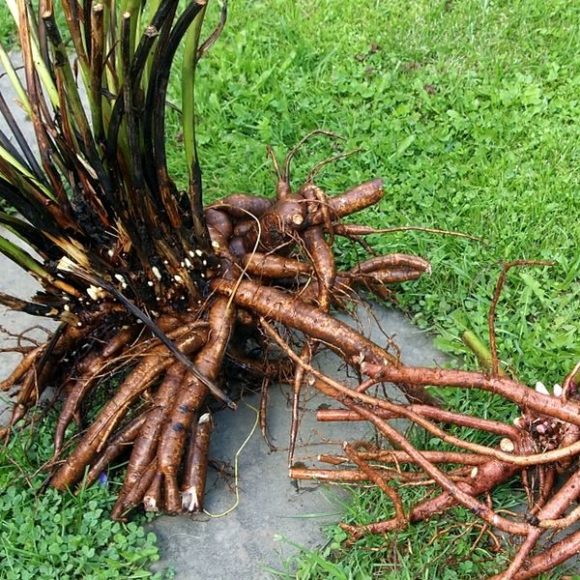

A layer of drainage material (expanded clay, broken brick, pebbles) is poured onto the bottom of the pit, then a nutrient mixture for the development of the plant. The soil should be rather loose, moisture and air permeable. Soil composition: mix one bucket of compost, peat, sand, and add a glass of wood ash and 50 grams of superphosphate. The remaining volume of the pit is filled with garden soil, cleared of weeds and roots. For shrinkage, the substrate should be well spilled with water, after which, if necessary, top up the soil.
When to transplant peonies - in spring or autumn
Peony transplant is a difficult process and does not always end positively for the plant itself. Many growers believe that the least harm to the flower system is done during the planting of peonies in the fall. Why this period is good:
- the active growth of young roots is just beginning, the growing season of the green mass of the bush ends, and transplantation will not harm them;
- there is time before frost, and this is important for a peony, since it does not take root immediately;
- autumn care for this representative of Compositae is simplified due to the onset of the rainy period.
In August, adventitious roots are not formed, but suction roots appear. It is necessary to have time to transplant peonies before their mass formation. Then the roots will not be damaged during digging, and the delenki will root well in the soil.
In the spring, these roots are already formed in April, so the bush is transplanted as soon as the snow melts. During this period, there are sharp changes in temperature, this adversely affects the seedlings. Experienced gardeners consider it correct to plant peonies in the fall.
Why you need to transplant peonies: the main reasons
Peony bushes are prone to overgrowth - with age, they become very lush and take up a lot of space in the flower bed. As a result, nearby plants are shaded and are also undernourished. In this case, either the division of the peony with further transplantation, or a complete change of "place of residence" will be required.
Peonies that grow in the same place for a long time often start to hurt and lose their quality of flowering. As a rule, a similar situation occurs after 10-12 years, therefore, to improve budding and maintain the health of the bushes, it is also recommended to replant them.
A transplant may also be needed for other reasons:
- Withering of the deciduous mass and the appearance of spots on it;
- Decrease in the growth rate of the bush;
- Planting purchased plants from pots to a permanent place.
If you plan to transplant peonies, approach this event as responsibly as possible - the plants are very sensitive to changing the place of growth and require a period of adaptation to new conditions.
Peony transplant recommendations
In order for peonies to grow healthy and strong, bloom profusely and with high quality, you must definitely find the right place for transplanting. The composition of the soil also plays an important role, as does its acidity.
Where to transplant: we select a place
Peonies love good lighting and do not tolerate drafts, so the area for their growth should be protected from the wind and be illuminated by the sun for 4-5 hours (in the morning). If, after lunch, a light shade falls on the flower bed, blocking the bush from the scorching sunlight, you can enjoy flowering for a long time.
The following areas are not suitable for transplanting peonies:
- Too shaded areas, where the sun practically does not get;
- Elevated places that are blown by the wind from all directions;
- Garden beds near large trees, shrubs and buildings;
- Low-lying areas where water accumulates during rains or melting snow.
Although the peony will grow in such conditions, you will not wait for regular flowering from it, as well as large buds.
Soil composition and site preparation


The optimal acidity level for pions is considered to be in the range from 6.2 to 6.8 units. For too acidic soils, it is necessary to pre-apply wood ash or lime (1 glass per 1 m 2).
Loamy or sandy loamy soils are recognized as the best for growing this culture, however, they also require preparation 2 weeks before planting the bushes:
- The selected place is cleared of weeds and dug up;
- Holes with a diameter and depth of about 60 cm are dug at a distance of 70-80 cm for low-growing varieties, 90-110 cm - for peonies of medium height, 130-180 cm - for tall and tree-like;
- A drainage layer of expanded clay, crushed stone, broken brick or gravel is laid on the bottom of the pits;
- A nutritious mixture is introduced from dolomite, bone meal (400 g each), superphosphate (80 g), ferrous sulfate (10 g) and potassium chloride (50 g);
- The excavated earth is mixed with coarse-grained sand, peat and compost in equal proportions and poured into the holes at half the depth;
- The pits are watered abundantly so that the soil begins to be saturated with trace elements.
Further care at the summer cottage
Caring for peony bushes does not require special skills. It is enough just to water, loosen and protect from diseases.
See also
Characteristics and description of the Etched Salmon peony variety, planting and careRead
Watering
Bushes need regular watering, especially during the budding period and during the flowering of inflorescences. Also, special attention is paid to irrigation in September. This is the time of secondary growth of the root system. For watering, you will need 2-3 buckets per bush.
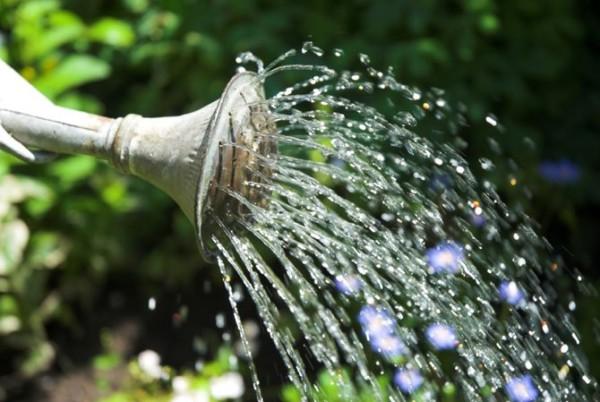

Loosening
From time to time around the bushes the soil is loosened and weeds are removed. This will help provide the flower's root system with the necessary amount of oxygen, which is needed for the full development of the plant.
Garter
During the rains, the stems of large-flowered peonies often lie down. To prevent this, the bushes are tied up. To do this, stakes are driven in around the plant and a wire or rope is pulled.
Diseases and pests
Like most plants, peonies are susceptible to various diseases and pest attacks. Most often, peony bushes are faced with such diseases.
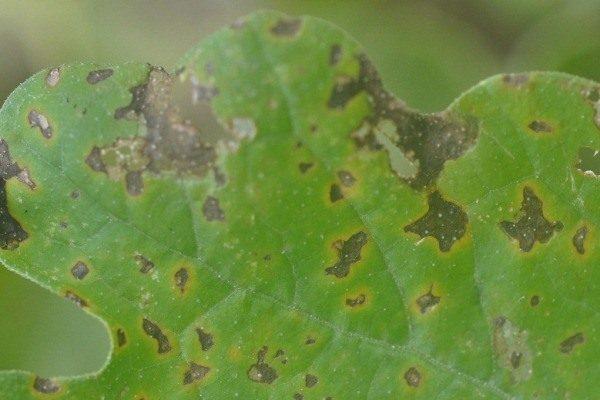

Gray rot
It belongs to the most dangerous diseases, as it affects all parts of the plant. First, young shoots begin to wither, and then mold appears. The affected parts of the bushes are cut and destroyed. For the winter, the shoots are cut to the very root, and with the arrival of spring, they are treated with Bordeaux liquid.
Powdery mildew
Mature bushes are more likely to suffer from this disease. A light bloom appears on the top of the foliage. Powdery mildew does not do much harm to peonies, but it still needs to be treated. To do this, the flowers are treated with a solution of soda ash, adding laundry soap to it. One and a half weeks later, another treatment is carried out.


Foliage mosaic
This is a viral disease that manifests itself as spotting on the foliage of flowers. Light green stripes alternate with dark green stripes, which resembles a mosaic. With a disease called "mosaic", necrotic specks may appear on the foliage. This disease is incurable, so diseased plants are removed from the site as quickly as possible and burned. Of the pests on peonies are found.
Ants
These insects are attracted by the sweet syrup, which is emitted by the flower buds. In the hunt for him, goosebumps eat up foliage and petals. In order to ward off insects from the bush, it and the soil around it are treated with repellents.


Bronzovka
It is a beetle with a mother-of-pearl back. He eats flower petals. Dangerous for peonies from early May to August. To get rid of beetles at the end of summer, loosen the soil under the bush. During this period, the process of pupation of the insect takes place. In the morning, parasitic beetles are harvested by hand. During the laying of buds, the bushes are sprayed with insecticides.
How is the transplant carried out?
It is recommended to start digging holes for transplanting peonies in the fall in the summer.They should be about eighty centimeters in diameter and seventy in depth. If it is necessary to transplant several bushes nearby, the holes should be made at a distance of more than a meter from each other.
Drainage must be laid in the finished pit. More than half of the hole (about two-thirds) should be filled with a potting soil consisting of garden soil, humus and sand. It is necessary to fertilize the soil a little and mix it with drainage, and then water it.
Until the moment of transplantation to another place, the prepared earth must be compacted. Before and after planting, you need to carefully monitor the acidity of the soil. In the Kuban, the transplantation of peonies in the fall to another place is carried out in the same way as in other regions, you can watch videos of professional gardeners and be convinced of this. Almost all flowers are unpretentious, especially if they are perennial.
- To transplant peonies, it is necessary to cut their stems almost to the very ground.
- After that, the plant must be carefully dug up - it is recommended to carefully dig in it from below, making a long trench.
- In order not to damage the root system of the plant, the digging must be done, stepping back from the extreme stems of the order of thirty centimeters.
- For maximum convenience, it is recommended to take out the trimmed peony with a pitchfork. Do not pull the plant out of the ground by the stems - this can damage its roots and buds, which are at its base and begin to develop for many years to come.
Taking a bush out of the ground, it is necessary to free its roots from excess earth with a shovel. Next, the peony needs to be put in a shady place for a couple of hours - during this time its roots will no longer be too brittle - and this is very important when transplanting.
Since the peony has an extensive rhizome with many stems, the gardener can choose the right one for planting. You need to choose young ones (they are painted in light, in places white) with a couple of shoots and several buds on the roots. The selected parts must be carefully cut with a knife. Places, breaks and cuts should be immediately treated with wood ash or a solution of potassium permanganate.
The pit is filled with garden soil, compacted well and watered abundantly (however, it is important to ensure that the roots of the peony are not flooded).
Dividing the peony bush
The correct execution of the division of the bush is not an easy task. The roots are usually too intertwined. The problem is finding the right parts of the rhizome.
When choosing such parts, attention should be paid to the adventitious roots, the presence of kidneys and, of course, the size.
A part for separation and subsequent transplantation can be considered suitable if it contains: 3-4 adventitious roots and 3-4 buds. Large parts with a large number of kidneys, experts advise not to use for transplantation.
If a rather old bush is to be divided and transplanted, then a wedge can be driven into the central part of the root system, which will help split it into several parts. Further actions must be performed based on the type and condition of the resulting parts.
Selected parts for transplantation must be carefully examined, having found rotten fragments, cut off, and also eliminate small root outgrowths. Next, you should process the entire bush with a composition with the presence of a copper component (copper oxychloride, Bordeaux mixture or something similar in composition).
When processing, special attention should be paid to the slices and process them in the most thorough way. After such a procedure, the places where the cuts were made must be sprinkled with charcoal.
At the end of the work, the seedlings are left in the shade on the street for at least a day.
Immediately before planting, the roots are placed in a potassium permanganate solution for 2 hours. Prepare a solution as follows: 1 g of potassium permanganate is dissolved in 3 liters of water. Such disinfection measures will help prevent rot on the roots.
Bush preparation
Before digging up a flower, you need to make sure that the planting site is prepared. The hole is dug out quite large to place prepared soil, mixed with humus, or purchased at a store.
- You need to dig in the bush carefully so as not to severely damage the roots.
- Do not touch the root system, that is, do not destroy the earthy clod formed around it.
- If the root cannot be saved, remove any old and damaged roots.
- Cut off the green stems, leaving about 10 to 15 centimeters from the root zone. That is, only sticks without leaves should stick out.
After completing all the steps, you can start landing. There are no specific regulations or restrictions. You can act however you like. The bush is perfectly adapted to any growing conditions. Natural and climatic conditions do not affect its flowering and other life processes. Of course, do not forget that decorative options for a perennial flower are more whimsical than simple ones.



